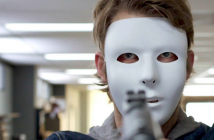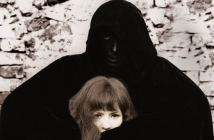Pather Panchali (1955)
Cast: Kanu Bannerjee, Karuna Bannerjee, Subir Banerjee
Director: Satyajit Ray
Country: India
Genre: Drama
Official Site: Here
Editor’s Notes: The following review is part of our coverage for TIFF’s The Sun and the Moon: The Films of Satyajit Ray. For more information on upcoming TIFF film series visit http://tiff.net and follow TIFF on Twitter at @TIFF_NET.
Akira Kurosawa once said of director Satyajit Ray: “Not to have seen the cinema of Ray means existing in a world without seeing the sun or the moon”. It’s hard to believe that Ray hadn’t aspired to be a filmmaker before making his debut feature Pather Panchali. Ray had been working as a graphic designer (something he never gave up and even invented several fonts that are named after him), painting scenes from the book of the same name when he started to daydream about his paintings coming to life on the big screen. It took him three years to achieve his dream and when it did come true, the result was tremendous.
Ray’s framing also helps to set his mood of struggle. He uses tight, confined framing to evoke the poverty of the primary family, but when we visit other homes of more prosperous families, there is more room to breathe.
The story is simple, it tracks Sarbojaya (Karuna Bannerjee) and her family as they struggle through life with her aspiring writer husband Harihar (Kanu Bannerjee), daughter Durga (first played by Runki Bannerjee, then older by Uma Das Gupta), Chunibala (Indir Thakrun) who is referred to as Auntie throughout the film and eventually Apu (Subir Bannerjee) (although all of the leads have the same last name, nothing I could find showed they are related, though I still like to think Ray cast a family to play a family whether he did or not). Sarbojaya understands the gravity of their situation, while Harihar always thinks something better is on the horizon.
The family’s reputation in the neighborhood is poor to say the least. They owe money to everyone and Durga frequently takes fruit from a neighbor’s orchard (which used to belong to the family but was sold to settle a debt). When Harihar gets steady work and some pickup jobs as a religious facilitator, he convinces Sarbojaya that everything is looking up and they have a second child: Apu. Six years later, the family is in even more dire straits as Harihar tries to make it as a writer and playwright. He goes off to seek work and leaves for months, leaving Sarbojaya to try to make things work with no money and counting herself four mouths to feed. Despite their reputation, when it comes down to it and the neighbors discover how bad off the family really is, they are genuinely helpful and worried for their well-being, reinforcing a sense of community where debts can be set aside during a struggle.
As this is going on, we are focused on Sarbojaya but drawn to Durga and Apu. Apu seldom if ever speaks, spending most of his time observing everything around him. Shots of Apu are mostly of him looking on at action instead of taking part in it. Durga is often an instigator, keeping up her thievery on low levels, mostly limited to fruit. The two are very close, and Durga is very protective of Apu. They baby him, despite his being six. He is fawned over like he’s going to be their salvation, which really shows the level of love they have for him and indeed the whole family.
Pather Panchali is one of the great debuts by a director. Ray launched not only his career but a trilogy centered on Apu from this film.
Ray makes the point to not make his characters too talkative or blatantly stay too much about their mental states. He instead relies on the body language of his largely nonprofessional cast. One of the only professionals, Karuna Bannerjee gives a startling and emotional performance as the long-suffering mother. There are moments where she just sits worrying and in some ways losing her mind with grief and the anguish from her circumstance. Her nerves are frayed a little more each time something new arises to the point where she just sits and holds her head in her hands on the brink of crying but seldom managing it.
Ray’s framing also helps to set his mood of struggle. He uses tight, confined framing to evoke the poverty of the primary family, but when we visit other homes of more prosperous families, there is more room to breathe. The sizes of the properties aren’t much different, but the feeling Ray imparts to them is. Only when Apu and Durga leave the home do they look and feel free. They roam around in the wooded areas, go to the river and Ray captures all of this with more of a scope than when they are at home. Apu and Durga sleep in a single bed together and there always seems to be someone, normally Sarbojaya, just over a shoulder. You can see his painterly eye at work with his shot compositions, taking care to establish from an upper level some shots to get topography but never letting the family seem like they can be alone.
To aid in the evocative nature of the film, Ray employed sitar master Ravi Shankar to do the music for the film. This was at least a decade before Shankar achieved international stardom after teaching Beatle George Harrison how to play the sitar. His music feels earthy and pure, setting a beautiful if unconventional undertone to the entire film. Sitar music is not known to be mournful, but Shankar achieves some doleful moments in his score.
After mentioning Karuna Bannerjee, I would be remiss if I left out Subir Bannerjee. This is the only film Subir ever appeared in and his family had to move to a remote area to avoid the press after the film debuted. Subir’s own wife didn’t know of his place in film history until he’d turned 60, 51 years after the film. As I mentioned above, he seldom speaks in the film. Rather, he fills his scenes observing what is going on around him. When the camera settles on him, he is often gazing inquisitively at something, quietly processing whatever action is offscreen. Some may read Apu as dimwitted, but I chose to consider him observant and curious. He wants to understand what is happening and he feels the best way to do that is not to intervene. I don’t mean to make it seem like he is wise beyond his years, I just mean that he is much more passive than his sister Durga. He sees the world through the lens of childhood, simple and uncomplicated. He’s not detached, things do affect him emotionally, but he remains distant.
Pather Panchali is one of the great debuts by a director. Ray launched not only his career but a trilogy centered on Apu from this film. The second, Aparajito followed the next year and is based on the sequel novel to Pather Panchali and the third, The World of Apu came three years and two films later in 1959. With Pather Panchali, Ray realized his dream of seeing his paintings come to life in grand fashion and in the process created one of the most effective and emotionally devastating films ever made. He weaves in family struggle, the complications of old age and the wonderment of childhood into a well-told and beautifully shot film. This is one of the greats that needs to be seen by all.
With Pather Panchali, Ray realized his dream of seeing his paintings come to life in grand fashion and in the process created one of the most effective and emotionally devastating films ever made.




